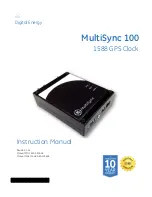
36 | Confidential
Global Positioning System (GPS)
The
Global Positioning System
(
GPS
)
is a space-based global navigation satellite
system (GNSS) that provides reliable location and time information in all weather and at all
times and anywhere on or near the Earth. As a national resource, it is maintained by the
United States government and is freely accessible by anyone with a GPS receiver.
GPS was created and realized by the U.S. Department of Defense (USDOD) and was
originally run with 24 satellites. It was established in 1973 to overcome the limitations of
previous navigation systems.
The first original satellite was launched in 1989, and the
24th satellite was launched in 1994. “Selective Availability” was implemented initially, where
the highest quality signal was reserved for military use and the signal available for civilian
use was intentionally degraded. On May 2, 2000 "Selective Availability" was discontinued as
a result of an executive order, allowing users to receive a non-degraded signal globally. This
improved the precision of civilian GPS from 100 meters (about 300 feet) to 20 meters (about
65 feet). Additional satellites were launched over the years to replace older ones.
A GPS receiver uses the messages it collects from the GPS satellites to determine the transit time of each message and
calculates the distance to each satellite. Although, signals from three satellites may seem to be enough to compute global
position, even a very small clock error multiplied by the “speed of light” with which message is delivered — results in a large
positional error. Consequently receivers use four or more satellites to calculate for the receiver's location and time. The
messages from satellites also carry a very accurate date and time stamp. About eight satellites are visible from any point on
the ground at any one time.
(Wikipedia)
The GPS signal is a line-of-sight signal so it is imperative that the GPS receiver antenna has a clear view of the sky. All
GPS tracking systems depend upon a well placed and functioning antenna. Some conditions that negatively affect the GPS
signal reception include driving between tall buildings, deep valleys, forests, mountain regions, underground parking or
tunnels or being indoors. Do not mount the GPS antenna under any metal surface. Once mounted, route the cable toward the
receiver. The cable is matched to the pre-determined length, so do not shorten or extend it. Avoid making sharp bends in the
antenna cable or winding excess cable into small, tight loops.
Summary of Contents for Qube4
Page 1: ...Qube4 M Nav800 Rev 05302013 Installation Training Troubleshooting 090...
Page 18: ...18 Confidential ConEx Sensor Monitoring...
Page 19: ...19 Confidential ConEx Sensor Monitoring cont Digital Inputs DI 1 to DI 4...
Page 20: ...20 Confidential ConEx Sensor Monitoring cont Digital Outputs DO 1 DO 2...
Page 27: ...27 Confidential Troubleshooting Section...
Page 34: ...34 Confidential Dimensions and Specifications Qube4...



































